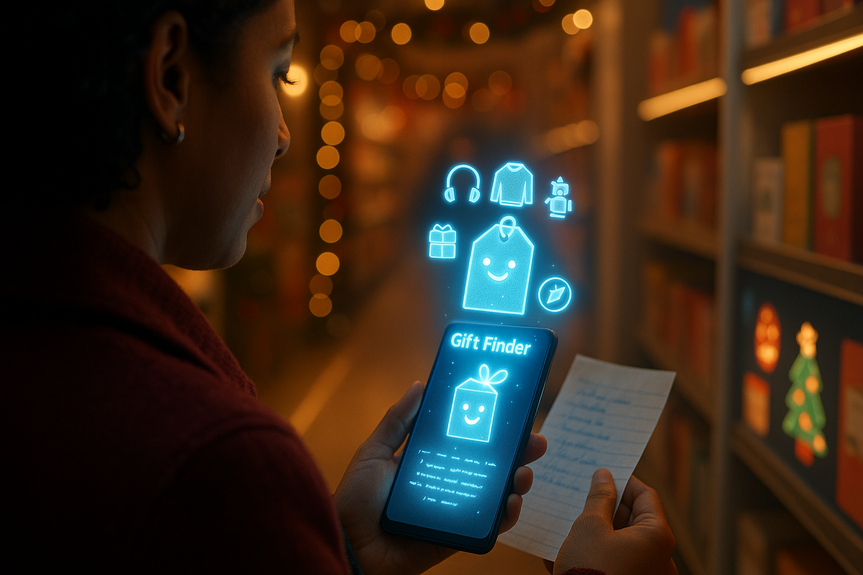best AI shopping assistants 2025 help you find gifts faster, compare prices and checkout securely.
Find top gifts faster with the best AI shopping assistants 2025. These tools compare prices, read reviews, track stock, and even guide you in stores. Use chat-style prompts to build lists, set budgets, and check out with confidence. This guide shows how to use today’s leading assistants to save time and money.
The 2025 holiday season is the first big test for AI-driven shopping. Retailers and tech giants are racing to put helpful bots in your pocket. You can now ask for a gift idea, get a short list, compare deals across stores, and walk straight to the right aisle. This guide explains what each tool does best and how to use them together. It also shows how to stay safe as “agent” bots start to place orders for you. By the end, you will know how to use the best AI shopping assistants 2025 to build better lists, skip busy aisles, and hit your budget.
Meet the best AI shopping assistants 2025
ChatGPT with Shopping Research and Instant Checkout (OpenAI)
OpenAI built a shopping research tool inside ChatGPT. You can type or speak a prompt like “gifts for a 10-year-old who loves space under $50.” The assistant scans prices, reviews, and stock, then returns a clear, ranked list. It explains why each pick fits and offers direct links. OpenAI says Instant Checkout is coming, which will let you buy in ChatGPT. Target and Walmart are among the first major retailers to connect their stores to this platform.
How to use it well:
Be specific: age, interests, budget, size, color, and need-by date.
Ask for pros and cons, not just a top pick.
Request a comparison table or side-by-side reasoning.
Add availability checks for your ZIP code or store pickup.
When to choose it:
When you want fast research across many stores and clear reasons “why.”
When you want one chat thread to plan your whole gift list.
Watch-outs:
Links and stock can change fast on peak days. Always refresh before you buy.
If Instant Checkout is available, check shipping speed and return rules before you confirm.
Amazon “Help Me Decide”
Amazon’s Help Me Decide analyzes your browsing and purchase history. It suggests the “right” product with one tap and explains the choice. It is great when you know the category (like noise-canceling headphones) but feel stuck between similar models.
How to use it well:
Open your recent browsing history before you use Help Me Decide.
Ask it to weigh key features: battery life, comfort, brand warranty, or price history.
Say “two options under $150, explain trade-offs, include deal timing.”
When to choose it:
When you are already shopping on Amazon and want a short, confident answer.
When you need a quick pick and fast Prime shipping.
Watch-outs:
It leans on Amazon’s catalog. If you want cross-store checks, use ChatGPT or Google as well.
Target Gift Finder, List-to-Cart, and Store Mode
Target rolled out three useful AI features:
Gift Finder creates short lists by budget, age, and interests.
List-to-Cart Scanning turns your written list into a ready-to-checkout cart.
Store Mode adds aisle-by-aisle navigation and even a “Find Bullseye” game to make errands fun.
How to use it well:
Build your list at home with Gift Finder, then switch to Store Mode in the parking lot.
Turn on navigation to grab items in the smartest route.
Use List-to-Cart to avoid missed items and double-buys.
When to choose it:
When you want a smooth online-to-store plan and easy pickup options.
Watch-outs:
In busy hours, item locations can shift. Re-scan for the latest aisle info.
Walmart’s AI-powered deal finding and navigation
Walmart’s new tools help you locate items fast, compare options, and find deals both online and in-store. Think of it as a guided path from the app to the exact shelf.
How to use it well:
Start with a prompt like “healthy stocking stuffers under $10, aisle location, and pickup by tonight.”
Ask for price comparisons with similar items and house brands.
Use store navigation for a fast in-and-out trip.
When to choose it:
When you want the lowest total cost and flexible pickup or delivery windows.
Watch-outs:
Deals change by store. Check your local store’s prices and inventory before you go.
Google Search and Shopping: AI Overviews, try-ons, and price tracking
Google blends search, shopping, and AI overviews. You can see virtual try-ons for fashion, get organized summaries, and turn on price tracking.
How to use it well:
Use natural prompts: “best beginner espresso machine under $300, reliable, easy to clean.”
Tap price tracking to get alerts when the price drops.
Open “similar items” to find better stock or faster shipping.
When to choose it:
When you want a broad view across many stores and brands.
When you need strong discovery and price alerts, not just one retailer.
Watch-outs:
Always click through to check seller ratings, return windows, and delivery dates.
Meta AI inside Instagram and Facebook ads
Meta is weaving its AI assistant into social ads. If you see an item you like, the assistant can answer questions and surface more options that match your style in real time.
How to use it well:
Ask for size advice, materials, and real customer photos.
Request a lower-priced lookalike or a bundle with free shipping.
When to choose it:
When you discover gifts by scrolling and want quick, chatty answers on the spot.
Watch-outs:
Social finds can be impulse buys. Confirm brand quality and return policies.
How to choose the right tool for each gift
Match the assistant to the job
Fast shortlists: ChatGPT or Target Gift Finder.
One-tap final pick on Amazon: Help Me Decide.
In-store speed runs: Target Store Mode or Walmart navigation.
Cross-store discovery and price alerts: Google Shopping tools.
Scroll-to-purchase questions: Meta AI in Instagram/Facebook.
Check the must-have features
Price tracking and alerting for budget control.
Local stock checks for same-day pickup.
Clear reasons “why” a product is best for your need.
Return policy, warranty, and delivery speed in the first view.
Privacy controls for history, lists, and saved preferences.
Set constraints before you search
Budget: Set a hard cap per gift and a total cap for the list.
Time: Note shipping deadlines and store hours.
Fit: Sizes, colors, and compatibility (like game consoles or phones).
Values: Eco-friendly, small business, or specific brands to include or avoid.
A step-by-step gift-hunting playbook
If you plan weeks ahead
Start in ChatGPT: “Create a gift list for Dad (hiking, coffee), Mom (baking, mystery books), and a 10-year-old (space, LEGO). Budget $250 total. Include 3 options each with pros/cons.”
Move top picks to Google to track prices and to find reviews across multiple sites.
Turn on stock alerts for your ZIP code to catch early sellouts.
Use Target List-to-Cart or Walmart lists to organize store runs.
Schedule pickup or delivery windows to avoid last-minute stress.
If you shop last minute
Open Target Store Mode or Walmart’s store tools for aisle-level guidance.
Ask: “Top 3 gifts under $25 in stock today near me. Show aisle and checkout time.”
Use voice search while walking, then follow the shortest route.
Use curbside pickup for bulky items and in-store checkout for small gifts.
Smart prompts you can copy
“Best cozy gifts for remote workers under $40, in stock locally, explain why.”
“Compare these two hair dryers: weight, heat settings, warranty, noise, price history.”
“Bundle gifts for a 6-year-old who loves dinosaurs and drawing, under $50 total.”
“Find a sustainable candle set with free returns, deliver by Dec. 20.”
Save money without wasting time
Price drops and deal timing
Turn on Google price tracking for high-ticket items.
Ask ChatGPT for typical holiday price ranges and when they drop.
Use retailer apps for exclusive promos that AI tools catch but do not always show in search.
Stack savings the smart way
Compare store coupons, loyalty points, and card offers in one plan.
Check if pickup discounts or “buy online, pick up in store” offers beat shipping costs.
Ask the assistant to calculate the real total with taxes, fees, and shipping.
Avoid false savings
Do not chase a small discount with slow shipping if your deadline is near.
Ask for quality signals: warranty length, verified reviews, and repairability.
Pick the item that will be used and loved, not just the steepest markdown.
In-store superpowers with AI
Turn lists into fast routes
Use Target List-to-Cart to convert your notes into a cart you can pick up or locate in the aisles.
Use Walmart’s navigation to sort your path by aisle location.
Scan shelf labels to confirm the right variant and avoid returns.
Make the most of busy hours
Start with the hardest items first before crowds hit those aisles.
Ask the app for a substitute if an item is sold out (same brand, size, price).
Use mobile checkout or self-checkout to skip lines when available.
Trust, privacy, and safe checkout
Understand “agentic commerce”
We are entering a phase where AI agents can place orders for you. Payments companies like Visa and Mastercard are preparing new security protocols to protect buyers and merchants as these assistants take action.
How to stay safe:
Approve the cart view before any agent checks out. Confirm item, seller, delivery date, and return policy.
Use strong authentication: device biometrics plus one-time codes.
Keep receipts and order numbers in your email and app vault.
Avoid clicking payment links sent by strangers in chats or DMs.
Review privacy settings in each app. Limit data sharing you do not need.
Spot legit deals
Check seller ratings and years in business.
Look for clear contacts: email, phone, and return address.
If the price is far below market without a reason, walk away.
What to expect next
More speed, more trust checks
Experts expect a surge in AI-driven shopping traffic this season. Industry trackers have projected over 500% year-over-year growth in chat-based shopping traffic, with spikes up to 1,000% on peak days like Thanksgiving. That means more assistants, faster tools, and better summaries. It also means you should double-check stock, shipping dates, and return windows at checkout.
Retail analysts say the market is still figuring out habits and trust. We will likely see tighter partnerships between the biggest retailers and the most capable AI platforms. Expect more “explain your choice” features, clearer comparison views, and flexible return labels baked right into the chat.
Where assistants will improve next
Direct-to-cart buying from chat across more retailers.
Smarter bundles that match budget and delivery dates across stores.
Shared lists for families with budget splits and delivery tracking.
Stronger fraud checks and clearer permission prompts before an agent pays.
Practical examples for different shoppers
For the budget watcher
Use Google price tracking plus Walmart online filters to keep under budget.
Ask ChatGPT for “best-rated under $25, explain durability in 2 lines.”
Pick pickup options to avoid last-minute shipping fees.
For the style seeker
Try Google’s virtual try-on to preview fit and colors.
Ask Meta’s AI for alternatives that match your style but cost less.
Check return policies for size swaps before buying.
For the parent on a deadline
Use Target Gift Finder to build a shortlist by age and interest.
Switch to Store Mode for aisle-by-aisle navigation and grab everything in one pass.
Keep a backup option in your list in case a popular toy runs out.
Bringing it all together
The strongest strategy uses two or three tools in a simple flow. Start with broad discovery (Google or ChatGPT). Narrow down with a retailer’s assistant (Amazon, Target, or Walmart). Confirm stock near you, then choose pickup or fast shipping. Use price alerts and deal stacking to save. And always do a quick checkout review for delivery dates and returns.
Here is a clean prompt you can paste into any assistant:
“Build a 6-item gift plan for: sister (running), dad (coffee), niece (STEM kits), friend (board games), coworker (snacks), neighbor (scented candle). Budget $180 total. Include price, stock near ZIP 30301, delivery by Dec. 20, and 1 backup per item.”
You can tweak that single prompt for any list. Keep your budget in the text. Add delivery deadlines. Ask for a one-line reason for each pick. If you want cross-store options, say so. If you want only one retailer, name it.
The AI holiday season is here. With the best AI shopping assistants 2025, you can cut search time, dodge stock-outs, and spend with confidence. Use them to plan, compare, navigate, and check out on your terms. Your gifts will arrive on time, your list will stay on budget, and your shopping will take fewer taps.
(Source: https://www.axios.com/2025/11/27/ai-shopping-tools-christmas-gifts-chatgpt)
For more news: Click Here
FAQ
Q: What can AI shopping assistants do to make holiday gift shopping faster?
A: The best AI shopping assistants 2025 can compare prices, read reviews, track stock, build shopping lists, set budgets, and guide you aisle-by-aisle in stores. They respond to chat-style prompts with ranked recommendations, explain why each pick fits, and can provide direct links and local availability checks.
Q: How do ChatGPT’s shopping research tool and Instant Checkout work?
A: ChatGPT’s shopping research scans prices, reviews, and stock to return a ranked list with explanations and direct links, and it accepts detailed prompts like age, interests, budget, and ZIP code. OpenAI says an Instant Checkout feature is coming to let users buy within ChatGPT, and best practice is to ask for pros and cons, side-by-side comparisons, and availability checks before purchasing.
Q: When should I use Amazon’s “Help Me Decide” feature?
A: Amazon’s Help Me Decide analyzes your browsing and purchase history to suggest a single “right” product with one tap and explain why it fits. It’s best when you’re already shopping on Amazon, know the category you want and need a quick pick with fast Prime shipping, and you should open recent browsing history and ask it to weigh key features like battery life or warranty.
Q: How do Target’s Gift Finder, List-to-Cart Scanning, and Store Mode help with planning and in-store runs?
A: Target’s Gift Finder creates short lists by budget, age, and interests, List-to-Cart Scanning converts your written list into a ready-to-checkout cart, and Store Mode adds aisle-by-aisle navigation and a “Find Bullseye” game. To use them well, build your list at home, switch to Store Mode in the parking lot, enable navigation for the fastest route, and use List-to-Cart to avoid missed items.
Q: What are some smart prompts I can copy for faster results?
A: Use targeted prompts such as “Best cozy gifts for remote workers under $40, in stock locally, explain why” or “Compare these two hair dryers: weight, heat settings, warranty, noise, price history” to get focused lists and comparisons. Include budget, ZIP code, and delivery deadlines in your prompt to capture availability and shipping details.
Q: How can I save money with AI assistants without wasting time?
A: Turn on Google price tracking for big-ticket items, ask ChatGPT for typical holiday price ranges and timing of drops, and use retailer apps for exclusive promos that AI tools might surface. Stack coupons, loyalty points, and pickup discounts, and ask the assistant to calculate the real total including taxes, fees, and shipping to avoid false savings.
Q: What steps should I take to stay safe when AI agents can place orders for me?
A: Always review and approve the cart view before any agent checks out, confirming item, seller, delivery date, and return policy, and use strong authentication like device biometrics plus one-time codes. Keep receipts and order numbers in your email or app vault, avoid clicking payment links from strangers, and review privacy settings in each shopping app.
Q: How should I combine multiple assistants into one shopping workflow?
A: Start with broad discovery in ChatGPT or Google, narrow down picks using a retailer assistant like Amazon, Target, or Walmart, then confirm local stock and choose pickup or fast shipping. Use price alerts and deal stacking, turn top picks into store lists or carts, and always do a quick checkout review for delivery dates and return windows.







